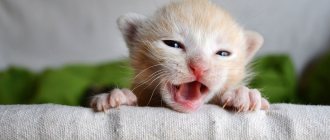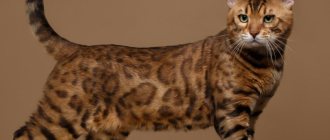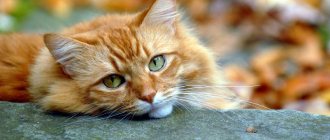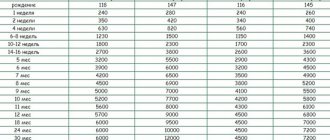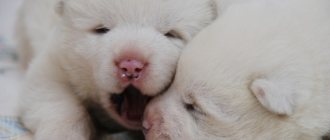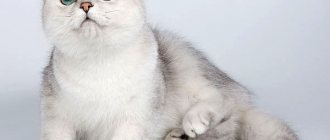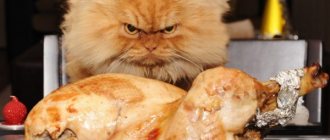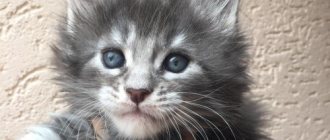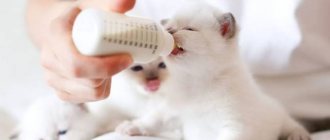It is advisable to carefully monitor your cat's weight at an early age. During this period, the kitten's weight allows us to evaluate the process of its development. Non-compliance with monthly norms may indicate malnutrition, illness and other abnormalities. Lack of weight gain is an alarming sign, so in this case you should immediately contact your veterinarian. It should be remembered that in the first weeks of life the pet is very vulnerable and the occurrence of any violations requires an urgent response.
Weight discrepancy
If the kitten in the litter looks smaller than the rest and is not gaining weight well, it is necessary to weigh it periodically to understand whether there is really something wrong with it. If after weighing it turns out that the baby is not gaining weight or the weight gain does not correspond to the table indicators, there may be several reasons.
For example, if the litter is large (5 or more kittens), the more active babies always occupy the nipples and push away the weaker one, so he does not have enough milk. Such a kitten needs to be placed near the cat more often than others, making sure that it has time to eat.
It is possible that the mother cat does not have enough milk, then all the kittens do not gain weight well. In this case, you will have to supplement the babies with special mixtures from a pipette. This can be a mixture for kittens or newborn babies. If the kitten looks lethargic and is not gaining weight well even after supplementary feeding, it may be sick with something. In this case, it is recommended to show the baby to the veterinarian.
Weighing procedure
To monitor the development of kittens, it is recommended to keep an observation diary. The babies' weight is recorded at birth and then weighed daily. After one month, it is enough to monitor the indicator once a week, and after two months - once every 30 days. The measurement procedure is carried out at the same time of the day, preferably in the morning.
The most convenient option for weighing is a kitchen scale. But not everyone has them; in this case, you can use ordinary floor scales.
In order to weigh a kitten, you need to weigh any adult family member, and then weigh him and the animal. The difference in weight shows the mass of the animal.
This indicator is recorded in a diary, then compared with tabular data.
Factors affecting baby's weight
In the first month after birth, the kitten rapidly gains weight; in subsequent months, the increase becomes less rapid; by the age of one year, the formation of the body is almost complete, and the weight reaches its maximum. Some large breeds can gain weight even before 2-2.5 years of age as they continue to grow. During each period, weight fluctuations are possible due to a number of reasons.
It is important to remember that weight fluctuations can be caused not only by malnutrition, but also by other, more serious problems, such as hormonal imbalances, heart problems or gastrointestinal problems. Weight gain is influenced by:
- Belonging to a certain breed . If the kitten was born from large parents (Ragdoll, Maine Coon), tables compiled specifically for these breeds should be used to determine weight gain. If the pet is not purebred, you need to pay attention to the weight of its parents (or at least the mother) and, based on this indicator, choose a weight table for newborn kittens.
- Gender of the kitten . Boys always turn out to be larger than girls, which is why they gain weight a little faster.
- Number of babies in the litter . The more kittens, the lower their weight at birth; accordingly, weight gain will not occur as rapidly as in the case of 1-2 kittens in a litter. In addition, some pets are more active, so they will push the weak ones away from the nipples, in which case some will be at normal weight, while others will lag behind in development.
- Diet of a mother cat during pregnancy and feeding her babies . If the animal is poorly fed, the babies will not receive enough of the vitamins and microelements they need, so their weight will not correspond to the table indicators.
- Health status of cats and babies . If the mother has parasites, the kittens become infected, so they do not gain weight well. Poor or excessive weight gain is an alarming symptom; the kitten may have hidden pathologies.
Diseases leading to obesity
Obesity in cats can be caused by hormonal imbalance, poor heredity or diseases that disrupt metabolism. But in practice, such health problems are isolated cases. Much more often lead to obesity:
- poor nutrition. If a cat's diet is too high in calories, the animal may not have time to burn calories, which turn into fat. Uncontrolled eating is also harmful. Not all cats can independently regulate the amount of food they need, so monitor the frequency of feeding and portion sizes;
- sedentary lifestyle. A lazy cat simply hoards calories. Outdoor games will help here;
- castration. Castration can cause hormonal imbalances that lead to weight gain.
It's better not to wait for the cat to turn into a ball
Obesity is much easier to prevent than to treat. Excess weight worsens the quality of life of an animal, which gradually leads to diseases. Some of the consequences of obesity in cats include:
- heart failure;
- urolithiasis disease;
- diabetes;
- diseases of the musculoskeletal system;
- metabolic disorders and much more.
Development of kittens up to 1 month
The average weight of babies at birth is from 80 to 100 g; in larger breeds this figure can vary between 100-150 g.
Kittens are born with their eyes closed, in some breeds the eyes open slightly on the second or third day after birth (Sphynxes and some short-haired breeds), in others this period lasts up to 2 weeks. But open eyes do not mean that the pet can see. Vision begins to appear around the 21st day after birth.
If the baby was born with his eyes slightly open, it is necessary to darken the habitat and instill long-acting artificial tears (3 times a day) or regular boiled water (every hour) and massage the eyelid. Newborns also lack hearing, but the ability to respond to the smell of milk and the warmth of the mother is well developed. Babies at this age eat and sleep, so their daily weight gain is about 10-15 g.
After 10-14 days, the baby already reacts to sounds and light, takes his first hesitant steps. The babies' weight doubles, the little ones begin to show curiosity and explore the world. By the end of the first month, the kittens are already actively moving around the box, gaining some independence, but still feeding on their mother's milk. The weight of babies developing according to norms ranges from 250 to 500 g.
Features of development in the second month of life
By the end of the fourth week, the baby's teeth are forming, so feeding on mother's milk alone is no longer enough. The kitten gradually begins to try new food. The diet can include chopped boiled meat, sea fish, and canned food for small kittens. Complementary foods are allowed to be given in small portions, divided into 6 doses.
Babies also need water. A bowl of water should be within easy reach of them. Kittens become more active at this time and therefore need supervision from the owner. They strive to get out of the place allocated for them and explore the surrounding area, which is fraught with falls and injuries.
Increased activity requires an increased supply of calories to the growing body. By the end of the second month, mother's milk no longer covers all needs, so complementary feeding is mandatory. At the age of two months, babies’ stomachs are already capable of digesting solid food, so during this period it is recommended to separate them from the cat and transfer them to independent feeding. The optimal weight that meets the requirements of this age is from 0.5 to 0.7 kg.
History of the breed
Siberian cats have charmed people with their beauty for a long time. The breed was formed naturally, so it is very difficult to track the real stages of the formation of Siberian cats.
What is known is that ordinary cats were brought to Siberia back in the eighteenth century by merchants and artisan settlers. Some documents describe unique exhibitions of these beautiful animals held by merchants. At these shows, not only the excellent external qualities were demonstrated, but also the skills of the favorites.
Also, future Siberian cats lived in monasteries, which these strong animals protected from mice and rats. There are known cases when pets warned monks about the approach of criminals and enemies.
There are several versions of the origin of Siberian cats:
- According to the first version, cats brought by settlers from Eastern Europe crossed with wild cats of the forests and received offspring, which became the basis for the future breed.
- According to the second theory, the rock was formed naturally as a result of exposure to the harsh Siberian climate.
- According to the third version, domestic cats and Persian cats from China (which came to Russia through the Great Silk Road) gave birth to kittens that became the founders of the future breed.
Steppe and forest cats had a certain influence on Siberians, from which the former inherited excellent hunting skills, attachment to a certain territory, as well as the characteristic color of a magnificent fur coat.
In terms of their attachment to humans, representatives of this breed are often compared to dogs.
Third month of life
Kids at this age are alert and active; they spend most of their time playing and exploring their property. They ride on curtains, climb on sofas, beds, carpets on the wall. Not only the weight but also the growth of the kitten increases, the formation of the skeleton and muscles occurs. During this period, it is important to introduce more foods rich in vitamins, minerals and proteins into your diet. You can continue to feed your pet natural products or choose food designed for three-month-old kittens.
Combination nutrition is not recommended, since it is difficult to achieve the optimal balance of all necessary vitamins and microelements. Therefore, it is better to immediately make a choice: natural food or ready-made food (dry and wet). If you decide to feed with special foods, then you need to purchase premium formulations. This guarantees their quality and the future health of the animal.
By choosing ready-made food, the owner solves several problems at once:
- There is no need to compile a daily menu; it is enough to pour the amount of mixture indicated on the pack of food;
- time spent on shopping trips is reduced. It is enough to visit a pet store and purchase a supply of food so as not to go to the market every day in search of fresh food for your pet;
- the finished formulations are balanced, so there are no problems with nutritional quality.
By this age, the weight of the growing young is from 1.2 to 1.7 kg.
Exceeding the norm
In a city apartment, cats are most at risk of obesity, and if you add unhealthy diet to this, then problems with excess weight will not take long to appear.
An overweight cat has no waist at all, and its belly protrudes in both directions. Observe your cat, if it is difficult for her to lick herself and raise her paws, then there is a reason for this.
Take the cat in your arms and try to feel the ribs; they should be easily palpable, but not protruding. In the case of obesity, it will be problematic to feel the ribs, since they are covered with a layer of fat.
In most cases, obesity problems in pets can be controlled by adjustments in the diet, but sometimes obesity can be a symptom of other diseases, so it is better to seek advice from a veterinarian.
Crucial moment
After reaching three months of age, a new family is found for the kitten. During this period, he is already actively eating adult food, knows where the water is, knows how to lick his fur independently and even relieve himself in the tray. Moving to a new apartment causes stress for the baby. He stops eating, may meow pitifully or hide from people.
For some, this period passes in 1-2 days, others are a little more sad, but generally after a week the pet’s cheerfulness and appetite return. Due to moving and stress, your pet's weight may change slightly. By the end of the 4th month, the kitten should gain weight up to 2 kg.
Six months
At this age, the kitten has already grown to the size of an adult animal. The process of puberty can lead to estrus in cats and unplanned pregnancies, so girls need supervision. During this period, the first molt is observed.
Muscle mass and bones are not yet fully formed, so the weight of pets continues to increase, but at a slower pace. By the age of six months, the weight of the animal averages 3 kg.
Weight gain ends around the age of two. Bones and skeleton, as well as muscles, stop growing, and weight fluctuations may depend on changes in adipose tissue.
Breed standards
According to the standards approved back in the seventies of the last century, Siberian cats are quite large, strong cats. Their body is large, muscular and elongated. The head is round in shape. The eyes are large, almond-shaped, slightly slanted. See also a full description of the Siberian cat breed with photos.
According to standards, they can be green, yellow and brown. The limbs of Siberians are not very long, but very strong and muscular. The fur coat of these animals is thick and has water-repellent properties. The tail is thick and rounded.
